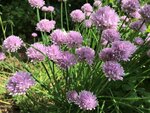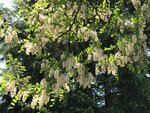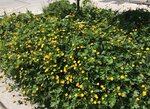


Three plants are having their peak moment this week: black locust trees covered in fat, pendant white blossoms; buttercups blooming everywhere, including in the lawn on the Capitol campus; and fat clumps of chives in full flower.
If you live anywhere near a black locust tree, you’ve probably been seeing its white blossom rain this past week. You might see drifts of those fallen petals on the roof of a neighbor’s garage, on the street, or anywhere else a breeze carries them.
These trees are blooming like crazy this year, and when they are covered in white flowers, they’re easy to spot, even when you’re zooming down the freeway. If you get close to one and the breeze is headed your way, you may get a wonderful nose-full of its sweet fragrance or hear the buzz of many happy bees.
But this is a controversial tree. It nourishes over 50 species of insects, which are food for birds, but its flowers, bark and leaves are poisonous to other animals and humans. It is a fast-growing shade tree with exceptionally hard, rot-resistant wood that is prized for fence posts, firewood and decks. Like its relatives in the pea family, it fixes nitrogen in the soil and thus enriches it.
But it can also be invasive, because it spreads both by abundant seed pods and roots that range widely and send up more trees. A single tree can soon turn into a grove that shades out native prairie, meadow, forest edge and stream-side plants. In a neighborhood, it can spread from one yard to another when no one is paying attention. Unwary homeowners or landlords may soon find a tree taller than their house within three feet of its foundation.
Still, black locust is not on the state’s or Thurston County’s Noxious Weed List, which would qualify it for actions to limit its spread. King County lists it as a “Weed of Concern,” which is a warning, but not yet an official listing.
But it’s hard not to love black locust right now, when it’s a beautiful sight and smell. And the bees sure are enjoying it.
Friends sometimes ask how to get rid of the creeping buttercups in their grass or gardens. But buttercups in a lawn are charming, especially when they are accompanied by little lawn daisies or flowering clover. My advice if they’re in a lawn is to let them be. They will stay green long after summer heat and dryness turns grass golden brown. If my front yard were entirely composed of buttercups, daisies and clover, I would celebrate.
In a garden, you have to use a shovel and dig under buttercup roots to pull them out. And you have to admire those robust roots. You also have to get rid of the runners (called stolons) that radiate out from the plant, just above the ground. Given a chance, they also send down roots. Buttercups know the secrets of success. According to the King County Noxious Weed Control Board, one plant can spread over a 40-square-foot area in a year.
The buttercups in our yards are one of at least three local buttercup species. One of those species is a native, and the other two – including the one in our yards – are immigrants. Tall buttercup, like the one in our yards, can invade and overtake pastures and poison livestock. It’s also not on any official Most Unwanted list, though King County lists it as a “weed of concern.”
It’s understandable that people get tired of fighting buttercups in their gardens, but really, if you take time to get out your shovel and dig up the roots, you can win. And really, you have to admit the flowers are adorable. Why else would “buttercup” be a part of so many song lyrics?
Sensible people plant chives in their vegetable gardens – but only until they realize that, like many herbs, it is a valuable addition to a flowerbed.
Chives are simple: good soil, regular water and some sun are all it takes to make them happy. When the flowers fade, cut the plant back and it will jump up and bloom again . . . and again. Three flowerings a summer is impressive, right?
Here are a few other chive virtues:
Jill Severn writes from her home in Olympia, where she grows vegetables, flowers, and a small flock of chickens. She loves conversation among gardeners. Start one by emailing her at jill@theJOLTnews.com
1 comment on this item Please log in to comment by clicking here
Terrilovesanimals
Thank you!! I love learning things about plants and things that are growing around here!
Sunday, June 11, 2023 Report this